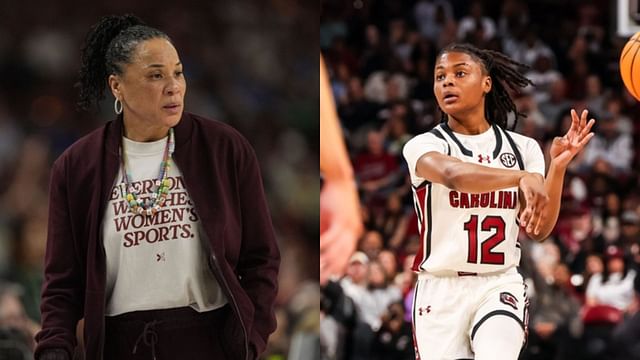MiLaysia Fulwiley, the standout guard known for her dynamic playmaking ability and electrifying athleticism, has entered the NCAA transfer portal, sparking widespread speculation and debate over her decision to leave the University of South Carolina and head coach Dawn Staley’s highly structured basketball system.
Fulwiley, whose arrival at South Carolina was hailed as a significant coup for the Gamecocks, quickly became a fan favorite due to her creativity on the court, explosive scoring capabilities, and undeniable charisma.

Despite the buzz surrounding her talent, her freshman season under legendary coach Dawn Staley was marked by limited minutes and restrained opportunities to showcase her full potential, leading many to speculate that the highly structured, defense-first approach of the Gamecocks’ program might have stifled her natural playing style.
Known for nurturing disciplined, defensively robust teams, Staley has built South Carolina into a perennial NCAA powerhouse, earning multiple Final Four appearances and national titles.
However, her system—which emphasizes team play, defensive rigor, and meticulous execution—can occasionally clash with the freer, more instinctive style of players like Fulwiley, who thrive on spontaneity and creative freedom.
Sources close to the situation have suggested that Fulwiley’s decision to enter the transfer portal may reflect a desire for greater autonomy on the court, as well as a chance to find a program better aligned with her unique skill set.
This move has reignited conversations within collegiate basketball circles about the delicate balance between structure and freedom, especially for young athletes whose talents flourish outside tightly controlled environments.
During her high school career at Keenan High in Columbia, South Carolina, Fulwiley garnered national attention with spectacular performances, demonstrating a rare blend of scoring, playmaking, and highlight-reel athleticism.

Ranked as one of the nation’s top prospects, her decision to stay in her hometown and play for the Gamecocks initially seemed like the perfect narrative.
Fans and analysts alike anticipated her immediate impact, envisioning a scenario in which Fulwiley would become a cornerstone of Staley’s already prestigious program.
Yet, her freshman campaign unfolded differently than expected.
Although she exhibited flashes of brilliance—moments where her talent was unmistakably evident—these instances were often brief.
Limited to short spurts off the bench, Fulwiley’s frustration was occasionally visible, fueling speculation among fans and media that the young star was struggling to fully adapt to Staley’s rigorous system.
Those close to Fulwiley indicate her decision wasn’t made impulsively but after considerable deliberation, including discussions with her family, mentors, and trusted advisors.
Her objective is clear: finding a collegiate program that embraces her style, allowing her to fully harness her capabilities while simultaneously fostering her growth and preparing her for a professional future.
Staley, renowned not only for her on-court success but also for her ability to mentor players toward success beyond basketball, has remained respectful and supportive publicly, emphasizing the importance of players finding their best personal fit.

Still, Fulwiley’s transfer decision represents a notable departure and raises questions about how programs, even highly successful ones, accommodate exceptional individual talents within team-oriented systems.
Analysts point to other high-profile transfers in women’s basketball history, drawing parallels to situations where players thrived dramatically after relocating to programs with contrasting styles.
This has bolstered arguments that Fulwiley could similarly flourish in a new environment, significantly boosting her draft stock and professional prospects.
College basketball experts have already begun speculating on potential landing spots for Fulwiley, with various top-tier programs expected to express interest.
Teams known for embracing high-paced, offensively oriented basketball could be particularly appealing, providing her the freedom to fully showcase the exceptional skill set that made her one of the most coveted recruits in the country.
Meanwhile, her departure leaves a notable gap for South Carolina.
The Gamecocks, while still loaded with talent, now face the task of filling the void left by one of the program’s most promising young athletes.
Fans and pundits alike will closely watch how Staley adjusts her strategies and whether this event signals broader shifts in recruiting or system implementation moving forward.
Fulwiley’s transfer decision underscores a critical conversation within collegiate sports about player autonomy, system compatibility, and how coaches balance the delicate task of maximizing team cohesion without compromising individual brilliance.
As more players seek transfers to better align their talents and aspirations, Fulwiley’s story could serve as a powerful example of the evolving landscape of NCAA basketball.
This transfer saga is more than just a shift of talent from one team to another; it represents an ongoing dialogue about the modern dynamics of collegiate sports, individual expression versus collective discipline, and the future of player empowerment in NCAA athletics.
As Fulwiley evaluates her options and ultimately selects her next destination, her story will undoubtedly continue to capture the attention of basketball fans, players, and coaches nationwide, marking a potentially pivotal moment for future athletes navigating their collegiate careers.



